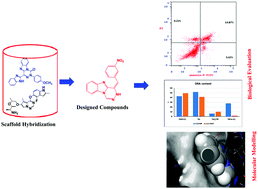The design and synthesis of potent benzimidazole derivatives via scaffold hybridization and evaluating their antiproliferative and proapoptotic activity against breast and lung cancer cell lines†
Abstract
One of the current approaches used in drug discovery and development is the synthesis of novel small compounds from existing structural motifs via molecular hybridization. In the current study, a new series of benzimidazo[1,5-a]imidazole, benzimidazo[1,2-c]thiazole, benzimidazotriazine, and benzimidazo[1,2-c]quinazoline scaffolds was synthesized via C–H cycloamination, using a metal-free synthetic pathway, as potent antiproliferative antiangiogenic molecules against breast (MCF-7) and lung (A549) cancer cell lines. The expansion of the benzimidazole scaffold with heterocyclic rings resulted in a tridentate cyclic system that occupied the ATP-binding site and neighboring hydrophobic pocket, eliciting promising affinity and selectivity toward VEGFR2 through extra H-bonding and completely occupying the entrance region. Molecular docking studies demonstrated that most of the designed compounds bind VEGFR-2 adopting a DFG-in conformation, where the benzimidazole scaffold occupied the hinge region, the central aromatic ring occupied hydrophobic region I adjacent to the hinge region, and the hydrogen bond donor/acceptor bound to the hydrogen-bond-rich region. In comparison to lenvatinib, which had a docking score of −12.47 kJ mol−1 and a Glide E-model value of −132.68 kcal mol−1, compound 17 had a decent docking score of −8.95 kJ mol−1 and a Glide E-model value of −92.17 kcal mol−1. The designed molecules exhibited promising in situ cytotoxic activities, with IC50 values ranging from 9.2 to 42.3 μM against MCF-7 and A549, comparable to 5-fluorouracil (which has IC50 values of 10.32 and 5.8 μM against MCF-7 and A549, respectively); they also showed selective in vitro inhibitory activity against VEGFR2 when compared with other designed kinases, with compound 17 showing an IC50 value (23 nM) as good as that of sorafenib (30 nM). Flow cytometry and cell cycle assays revealed that apoptotic cell death induction occurred in the A549 cell line through the activation of certain caspases and the tumor suppressor P53 and through repressing the generation of BAX and PUMA. Furthermore, the proposed compounds exhibited physicochemical and pharmacokinetics properties within the acceptable range for human usage, as anticipated by an in silico ADME study, making them lead molecules for developing new forms of medication.



 Please wait while we load your content...
Please wait while we load your content...